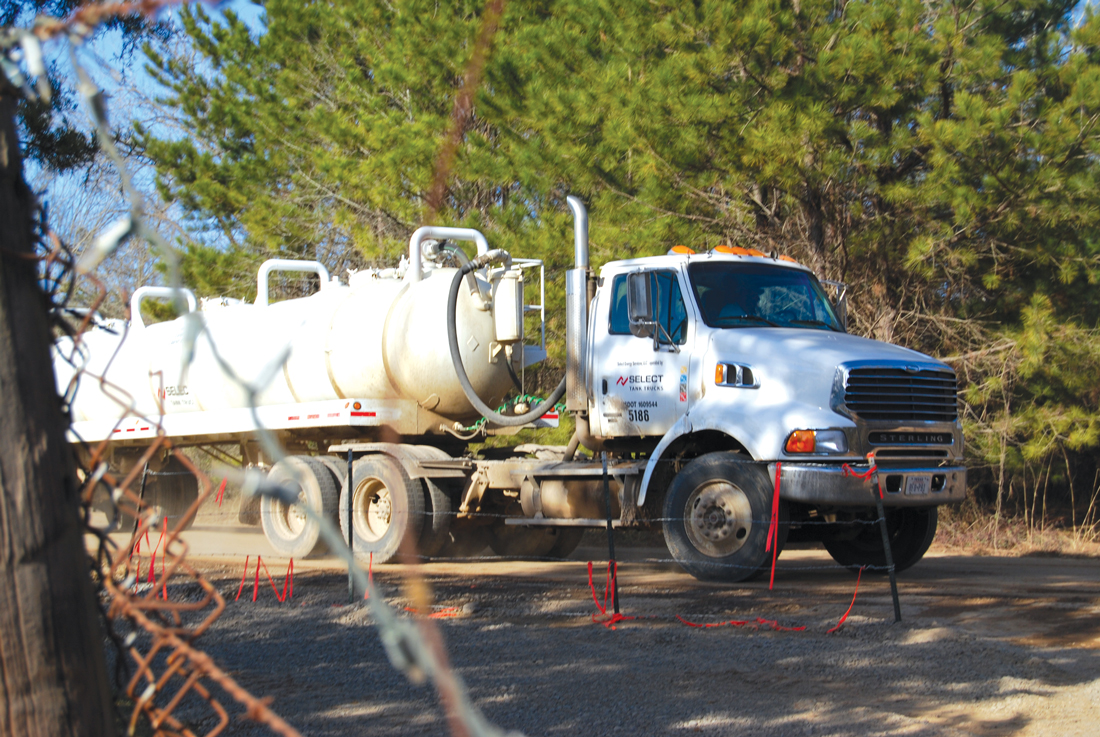Texas property owners can post their land against trespassers. But what do you do when the interloper is toxic liquid spreading far beneath the surface of your land from someone else’s well and possibly poisoning your water supplies?
The Texas Supreme Court was to hear arguments on that question this week, in a case that industry groups say could significantly threaten oil and gas drilling in Texas by limiting the use of injection wells to dispose of millions of gallons of waste products. Critics say it’s about time for Texas courts to set better limits on drillers’ ability to affect others’ property rights and values and to threaten the state’s underground water supplies.
The party asking for relief in this case is a rice farming operation in southeast Texas. According to filings by FPL Farming Ltd, liquids from an injection well on nearby property have contaminated a saltwater aquifer under the farm — an aquifer that isn’t being used for drinking water but conceivably could be, with desalinization. The well in question doesn’t handle toxic drilling wastes — but a ruling could apply to those kinds of wells. And it could pit drillers against ranchers, farmers, and other big landholders in shale drilling regions around the state.
If the state’s highest civil court accepts the theory that trespass laws apply to the migration of liquids injected far below the surface, the ruling “would be the first of its kind in the United States,” said Cory Pomeroy, vice president and general counsel for the Texas Oil and Gas Association.
The oil and gas industry “is dependent on disposal wells to safely manage the wastewater that results from oil and gas production,” he said. “This is an important case.”
In a friend-of-the-court brief, the trade group said that the more than 50,000 injection wells permitted by the state are “critical to the production of oil and gas.” The brief said that, when it comes to oil and gas production in Texas, “subsurface property rights … are not absolute.” The brief also noted that after the wastewater is injected deep into the earth, horizontal migration of those liquids — perhaps for dozens of square miles — is inevitable and impossible for well operators to predict or control.
“It’s interesting that they would even say that in a legal brief,” said Gary Hogan, president of the North Central Texas Communities Alliance, a frequent critic of gas drilling operations.
Jim Popp, a Wise County landowner whose unsuccessful fight against a proposed injection well made Texas case law several years ago, said he’s not surprised that the industry would seek to avoid responsibility for encroaching on other landowners’ property and for harm potentially caused by the wastewater wells.
“The industry will do anything to keep injection wells in Texas,” Popp said. Some cities and some areas in the Marcellus shale region, in the northeastern United States, don’t allow injection wells “and for good reason,” he said. “You’re looking at at least 27 different kinds of toxic waste, including benzene, and you’re spreading that out, and people know it’s under their property.” Injection well leakage has migrated to the surface in some instances already, he said, and killed trees and caused other kinds of damage.
The FPL case, against a disposal well operator called Environmental Processing Systems, has already been to the Texas Supreme Court once. In that round, the Supreme Court disagreed with lower court findings that the existence of a state permit for the well shielded the operator from liability and sent the case back for reconsideration.
Pomeroy said the process of proving how liquids move underground is difficult and highly error-prone. But having such proof “is an absolutely crucial element in settling this type of issue.”
In a story in the Dallas Business Journal, staff writer Nicholas Sakelaris quoted Dallas attorney Holt Foster as saying the FPL case could have a dramatic effect on property rights. “This could open the barn door, and third parties could start suing their neighbors,” Foster said.
That would be fine with Popp. He noted that the drilling industry could hugely reduce its dependence on disposal wells if companies made more use of desalinization techniques such as those used by Devon Energy. Devon, he said, reuses 80 to 90 percent of its water, “so they don’t need millions more gallons” every time the company uses hydraulic fracturing on a new well. “Of course, the process costs them a lot more money,” he said.
Critics of the disposal wells, which inject drilling waste fluids at high pressure deep underground, say there are many reasons that such wells should be better regulated and more sparingly used. One is the fear that, indeed, the injection process is not nearly so predictable and safe as drillers have painted it and that the toxic fluids could escape and foul underground aquifers — an increasingly critical problem as Texas’ water supplies come under more pressure from population growth and climate change.
Another problem are the earthquakes that in the last few years have begun to plague parts of Texas and other states with lots of drilling activity. Researchers have found a strong connection between the quakes and injection wells, so much so that such wells have been shut down in some areas in other states.
“What they’re injecting is lubricating the [tectonic] plates,” and leading to the quakes, Popp said.
“Let me tell you this,” he said. “I’m a conservative. I’m for drilling here, drilling now. We need this energy. But let’s do it safely, for goodness sakes, for this generation and future generations to come. I have grandchildren. I want them to be able to live safely and drink the water without worrying.”













Cory Pomeroy is revealing too much insider information–information we already knew, but that has never been admitted before by the O&G mafia. He may have cooked his own goose as an industry spokesman.
He also attempts to amend property law through assertion. He says, “subsurface property rights…are not absolute.” Really? Then if the law is not definitive, the rights of whoever controls mineral “rights” are in question. Or is he saying that statement only applies to the fee simple owner who signs a mineral lease–not to the lessee?
Then he says that after injection wastewater migration horizontally for dozens of square miles cannot be predicted or controlled. Hello? That means the O&G mafia knows this happens but doesn’t care and is not responsible. So…that means nothing can or will be done if it does happen (which it does).
Then Mr. Popp asks for the impossible: “We need this energy, but let’s do it safely.” Easy to say, but it’s an impossibility. How much of the income from O&G production is spent on research into alternate renewable energy sources? As little as possible, because the O&G industry can’t make as much profit from that as they can by keeping humanity dependent on a dwindling finite supply of O&G as the law of supply and demand causes exponentially increasing prices for that energy.
In Static, below the Toxic Torts article, another ploy of the O&G moguls is discussed. Corrupt Railroad Commissioner, David Porter, states, “Commission rules and regulations must be based on sound science and proven facts.” Of course Porter does not know science from voodoo. He is an O&G accountant. And someone needs to ask, “What would you accept as proof, and why and how is that achievable?” Because the fact is that it can never be determined where, exactly, a molecule of a BTEX chemical or other known carcinogen present in O&G wastewater originated. So, direct evidence cannot be obtained. One must accept circumstantial evidence. Pinheads like Mr. Porter draw the line there. Oh, no! That’s not proof, they will say.
When earthquakes suddenly start happening in an area that has never ever had earthquakes before an injection well was drilled and used, that is circumstantial evidence of a quality that has been sufficient to place defendants on death row. More than 70% of those on death row were convicted on circumstantial evidence no more certain than the correlation between injection well operation and earthquakes. Proof of the existence of elementary particles has rested on indirect (circumstantial) evidence.
O&G investors and paid managers or industry executive officers have no business defining what constitutes proof that any of the public health and public safety issues associated with O&G production are acceptable.
Not long ago, when I used to live not too far from Jim Popp, David Porter referred to me, my wife Christine and two of our neighbors, Bob and Lisa Parr, as “Unsatisfied Landowners” in a Ft. Worth Star Telegram Op Ed piece.
Jim’s a good guy, and with all due respect, you won’t find too many conservatives that support more accountability on oil and gas industry.
While drilling punctures through water tables and common sense says that there is no doubt some water contamination happens at that time. And while casings do fail eventually to also risk water contamination, there is the step child of this whole fracking mess called injection wells. Currently, injection wells are getting alot of attention for being the cause of seismic events which in itself risks the all types of nearby well’s casings. But this story is about KNOWN, HISTORIC, REPORTED, UNCOVERED, “formerly confidential info” about how injection wells cause ground water contamination.
In July of 2012, I dug into a US General Accounting Office study that was originally marked C O N F I D E N T I A L back in summer of 1989 … here is some information to give you the pieces that I felt were relevant to save you folks some time….
http://www.gao.gov/assets/150/147952.pdf
“EPA did not issue regulations for primacy states (KS, TX, NM, & OK) to follow in developing their programs but issued less binding guidance documents, which specified a number of basic safeguards to protect against drinking water contamination. The guidance includes:
(1) operator-conducted pressure tests to check for cracks and leaks in the wells before they receive a permit to begin operations and
(2) pressure tests and reviews of well files for wells that were already operating under state programs before the federal program went into effect to make sure the wells had been properly constructed and were being properly operated.
While (US General Accounting Office) GAO’S evaluation of contamination cases was nationwide, its evaluation of how safeguards have been implemented focused only on state administered programs, under which most Class II wells are regulated. GAO analyzed, in late 1987 and early 1988, a randomly selected sample of Class II wells in four of the primacy states-Kansas, New Mexico, Oklahoma, and Texas to determine the extent to which states implemented program safeguards. About two-thirds of the state regulated Class II wells are located in these four states.
Although the full extent is unknown, EPA is aware of 23 cases (plus 4 suspected) nation wide in which drinking water was contaminated by Class II wells. In many of these cases, improperly plugged oil and gas wells in the vicinity of injection wells served as the pathway for brines to reach drinking water. Although operators of wells that began operating after the program went into effect are required to search for and plug any improperly plugged wells in the immediate vicinity of their injection wells, this requirement does not apply to those Class II wells that were operating before the program. Injection wells already operating before the program accounted for nearly all of the cases in which contamination has occurred through migration into improperly plugged wells. Moreover, GAO estimates that at least 70 percent of its universe of Class II wells were already operating before the program and therefore have not been subject to the requirement to search and plug nearby improperly plugged wells.
Although the four state programs we analyzed require the safeguards that are currently part of EPA’S program, some of these states are issuing permits to operate new Class II wells without evidence that pressure tests were conducted, and some have not finished reviewing files and pressure testing some of the existing wells. EPA and the states have taken steps to address some of these problems, but the states still need better documentation before issuing permits.
The full extent to which Class II wells have caused drinking water contamination is unknown, largely because the method for detecting contamination-installing underground monitors can itself create a conduit for contamination and is therefore not widely used.
Among the 23 known contamination cases, most resulted from cracks in the injection wells or from injection directly into drinking water; these cases were discovered, for the most part, as a result of required pressure testing and file reviews. However, in more than a third of the known cases, drinking water became contaminated when injected brines traveled up into improperly plugged abandoned wells in the vicinity of the injection wells and entered drinking water through cracks in these old wells.
Since all but one of these injection wells were already operating at the time the program took effect, searches for and plugging of improperly plugged wells in the vicinity of the injection wells were not required. Contamination was not discovered, for the most part, until water supplies became too salty to drink or crops were ruined.
In 1976, before beginning the program, EPA proposed requiring all operators to search for and plug any improperly plugged abandoned wells within a 1/4 mile radius of their injection wells. However, commenters objected to making all wells subject to this rule because of the high costs involved. EPA decided to exempt those wells already operating, reasoning that because of the proximity between new wells and existing wells, the searches undertaken in the l/4-mile radius of new wells would eventually uncover and result in the plugging of all the old wells.
(obselete statement)…Since then, however, relatively few new injection wells have come into operation. As a result, less than a third of GAO’s universe of wells has been subject to area-of-review requirements. On the basis of a survey of old oil and gas production records, EPA has estimated that there are approximately 1.2 million abandoned oil and gas wells in the United States, of which about 200,000 may not be properly plugged. Moreover, among the four states that GAO examined, state officials in all but New Mexico believe that the numbers of improperly plugged wells are increasing – the result of the current (drillers going bankrupt) economic decline in the oil industry.
Although these four states have programs to plug these wells, Texas and Oklahoma officials said they now have more wells to be plugged than they can afford to pay for, and Kansas officials fear that with the increased numbers of wells reported each year, their plugging program may not be sufficient in the future.
At the time of GAO’s (General Accounting Office) review of well files in late 1987 and early 1988, implementation of program safeguards in the four states reviewed was mixed. GAO found that the files of 41 percent (with a sampling error of + 14 percent) of the wells with permits contained no evidence that pressure tests had ever been performed, even though these tests are required before start-up and every 5 years thereafter. In three of the four states GAO reviewed, internal controls were not in place to ensure that all necessary documentation was on file.”
pg 11….”If contamination is extensive, however, and covers a large area, rehabilitation may be extremely costly. In these cases, if the aquifer is left to cleanse itself, the process can take as long as 250 years.”
pg19…..”Injection wells already operating comprise at least 70 percent of the estimated 88,000 Class II wells in our universe. According to EPA improperly plugged wells near operating injection wells present significant environmental problems.”
pg23….”..about half the known and suspected cases were discovered only after contamination had become obvious to the people affected, for example, when their well water became too salty to drink, their crops were ruined, or when they could see water flowing at the surface of old wells. Neither EPA nor the states routinely require groundwater monitoring for Class II wells.”
pg24….”The 23 cases in which contamination was confirmed can be traced to three principal causes: five cases resulted from leaks in the casing of the injection wells, nine cases resulted from injection into the USDW (underground source of drinking water), and nine resulted from migration of brines from operating injection wells into nearby oil and gas wells that had been left unplugged or improperly plugged.”
pg25… ”In the other 18 cases, EPA or the state decided that cleanup was either technically not feasible, too expensive, or not practical because the aquifer was already high in brine content and not usable for drinking water without treatment.”
pg31…..”The importance of having sufficient safeguards is underscored by the fact that there are usually no practical remedies once contamination occurs. For most of the 23 confirmed cases, the drinking water sources that were contaminated will remain so for (as long as 250) years until natural processes restore water quality.”
pg35….”In Texas, officials acknowledged that they rarely reviewed the accuracy of information submitted to satisfy area-of-review requirements because of the time and staff required…..We found that those wells in Texas that had no record of pressure tests had all been issued permits before 1986 and were therefore not required to submit evidence.”
End
———–
Pressure tests can and have been faked….we cannot trust the O&G industry..period.
Texas Sharon blogged back in 2008 that Peggy Heinkel-Wolfe, a local fearless reporter, wrote…”Texas has nearly 78,000 injection wells, including about 50,000 of the nation’s 144,000 Class II wells used for “exempt” oil and gas wastewater.”
So it was no surprise to me that the ATSDR reported on the following link http://www.atsdr.cdc.gov/toxprofiles/tp115-c6.pdf on Table 6-1 called “Releases to the Environment from Facilities that Produce, Process, or Use Phenol” that in 2005Texas contributed 83% (1.2 million pounds per year) of the United State’s Phenolreleased via Class II Underground Injection Wells.
So if this is the 2005 figure, read on to figure out how much we dispose by now.
http://www.texastribune.org/2013/03/29/disposal-wells-fracking-waste-stir-water-concerns/ reported…“The amount of wastewater being disposed of in Texas wells has skyrocketed with the spread of fracking, to nearly 3.5 billion barrels in 2011 from 46 million barrels in 2005, according to data from the Railroad Commission of Texas, the state’s oil and gas regulator. On average, companies in Texas dispose of 290 million barrels of wastewater — equivalent to about 18,500 Olympic-size swimming pools — each month.”
You do the math with me…..
ATSDR says in 2005 that 1,225,500 ppy (pounds per year) of phenol was injected in TX.
RRC says in 2005 that 46 million barrels of waste water was generated that had to be injected. That means for every 38 barrels of injection waste, that one pound of Phenol (a major metabolite of Benzene) was generated. Keep in mind that one teaspoon of Benzene contaminates about 261,000 gallons of water…
What can people do about the threat to their property if Eagle Mountain Lake dam ruptures.
Azel has experienced 30 earthquakes in two months in an area that barely had any quakes before fracking began.
The number of earthquakes has increased dramatically over the past few years within the central and eastern United States,” the United States Geological Survey says on its website. “More than 300 earthquakes above magnitude 3.0 occurred in the three years from 2010-2012, compared with an average rate of 21 events per year observed from 1967-2000.” The USGS says that at some of those locations, disposal wells are behind the quakes.
Yet, the Railroad Commission tells us there might be a hypothetical link between earthquakes and disposing fracking fluid in abandoned wells. I suppose that if someone hit them on the head with a sledge hammer thirty times in two months, they would ask the tormenter to stop even if the link between the beatings and their pain was hypothetical.
The epicenter of one of these quakes was only 2.5 miles from the earthen dam. Built in 1932, this dam is rated as a high-hazard dam. Earthquake experts suggest that moderate, shallow quakes close to the surface and close to the dam could produce large enough ground motions to threaten the dam.
Eagle Mountain Lake contains ten times as much water as Lake Conemaugh that produced the Johnstown flood (1889). With a temporary flow like the Mississippi River, That flood killed 2,200 people and caused $420 million damage. A flood ten times that size could produced $4 Billion dollars of damage.
Most of us built earthen dams on small creeks as children. None of us was ever successful in stopping the water because, water penetrated any small crack and destroyed our dam.
The image of engineers monitoring the dam with strain gauges isn’t comforting. By the time that cracks are detected, the damage is already done. Ask the Corps of Engineers whether they can even locate, if not to mention, repair a crack in a dam, even if they drain the lake.
What will happen if the Eagle Mountain Lake dam fails? Lake Worth downstream can’t hold all that water. It will flood down the West Fork of the Trinity River, swooping 270 degrees around downtown Ft Worth, on through Arlington, destroying homes and businesses, and who knows what will happen in Grand Prairie and Dallas.
The property insurance industry tells us that after Katrina most buildings were inadequately insured for flood damage. Afterwards, insurance rates increased dramatically, rendering it nearly impossible to afford flood insurance. Should the Lake Worth dam rupture, business and homeowners insurance rates all over the state will explode. My homeowners insurance just increased $500 per year due to hail storms stemming from climate change. That’s $500 every year for the rest of my life.
But apart from the financial costs, how will we replace Lake Worth, the source of 10% of our community’s water supply?
The good news is that earthquakes have stopped in some places when the disposal of fracking fluid ceased. If the Railroad Commission chooses to ignore the danger, they may be held accountable for 20,000 deaths and for $4 Billion dollars of property damage.
Visit this link for more on known contamination documents from the GAO on injection wells. http://barnettshalehell.wordpress.com/2014/01/07/injection-wells-are-known-conduits-to-ground-water-contamination-gao-confidential-doc/